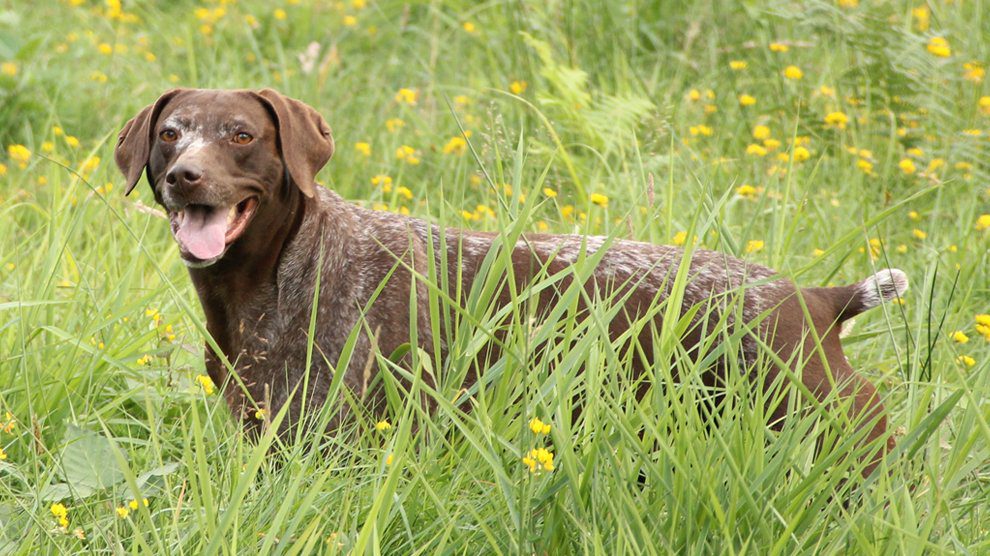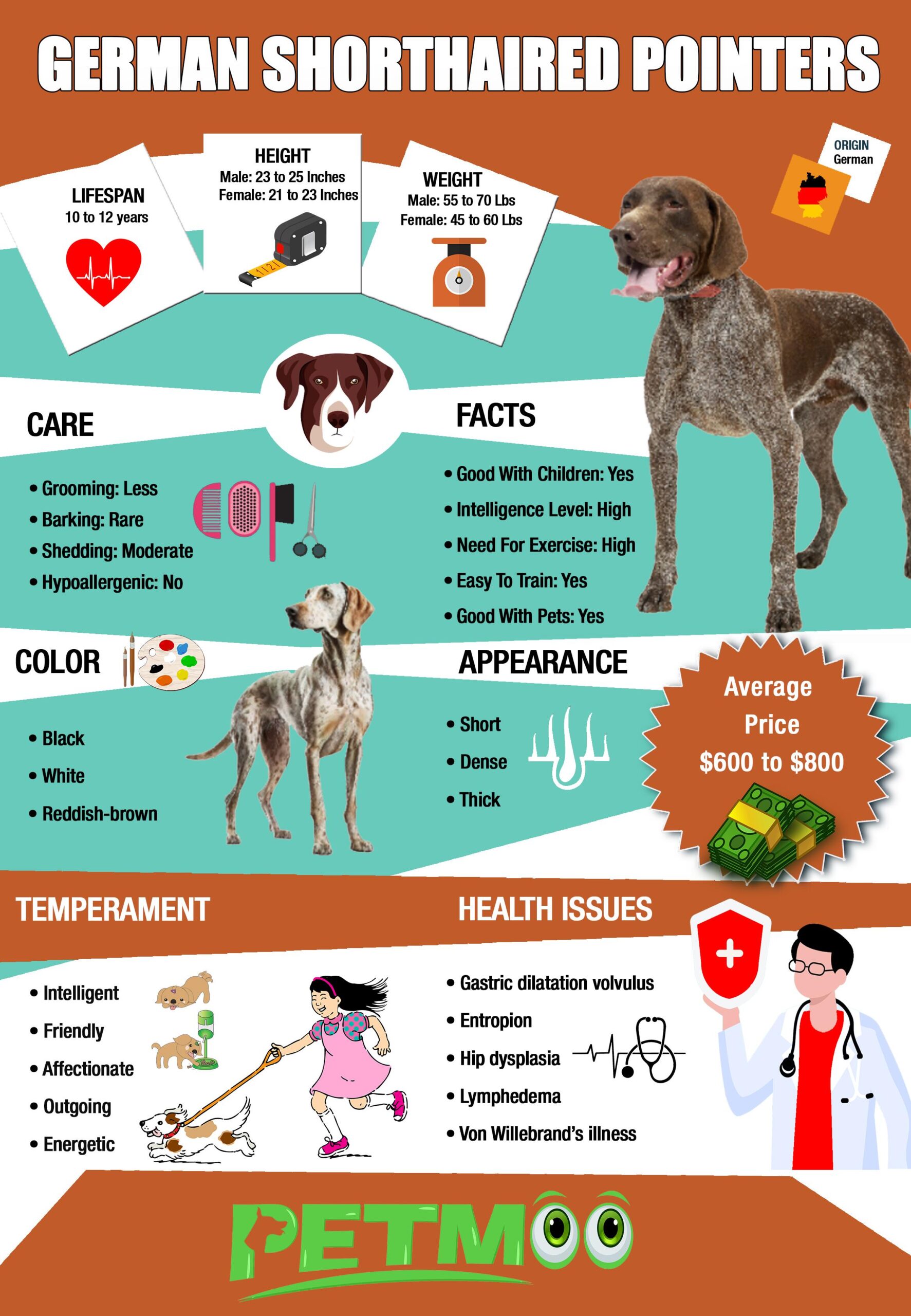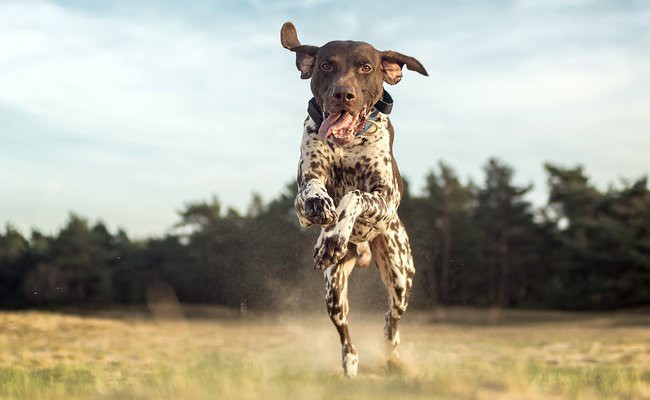Dog Pregnancy Calculator And Timeline
Have you ever come across a versatile, enthusiastic and challenging hunting dog breed? If you haven’t had such experience, get a German Shorthaired Pointer.
Developed in Germany for the sole purpose of hunting, it can be described as a medium-sized, multi-faceted, gun dog. Agile with its strong legs, the German Shorthaired Pointer can hunt different types of game.
Suitable for both water and land (i.e. game hunters and water retrievers), it has the ability to do any job. This dog had even served in the bomb detection department of the United States Air Force. An affectionate companion, it is a wonderful choice for active families, too!
If you are a kind of person who spends the most time in the outdoors, this breed is the best companion. It can also accompany you for long hikes or run. This dog will be the right pet for you with its distinctive abilities and features.
- Long, cute floppy ears and strong, broad muzzle of this breed help it to retrieve or fetch even powerful game.
- They are good at hunting waterfowls with its purled feet.
- It will be a great watchdog for your family. This dog will likely bark if someone’s at the door or on your property, but won’t be aggressive with strangers or other pets.
- You can easily maintain this dog with minimal grooming needs.
- Its size and protective nature will help for the safe dawn training.
The only demand from these dogs is plenty of exercises for their physical and mental stimulation. If you’re able to provide it, the German Shorthaired pointer will be your best four-legged fur baby.
Let’s get into the details of this amazing breed in this article.
German Shorthaired Pointer Breed Characteristics
- Origin: Germany
- Size: Medium
- Dog Breed Group: Sporting, Hunting
- Purebred: Yes
- Lifespan: 10 to 12 years
- Height: 23 to 25 inches (males); 21 to 23 inches (females)
- Weight: 55 to 70 lbs (males); 45 to 60 lbs (females)
- Coat Appearance: Short, dense, thick
- Coat Colors: Black, White, Reddish-brown
- Temperament: Intelligent, Friendly, Affectionate, Outgoing, Energetic
- Good With Children: Yes
- Intelligence Level: High
- Good With Pets: Yes
- Hypoallergenic: No
- Grooming: Less
- Shedding: Moderate
- Barking: Rare
- Suitable For Apartments: No
- Need For Exercise: High
- Easy To Train: Yes
- Good For First Time Owners: Yes
- Health Issues: Gastric dilatation volvulus, Entropion, Hip dysplasia, Lymphedema, Von Willebrand’s illness
- Litter Size: 7 to 12 puppies
- Average Price: $600 to $800
German Shorthaired Pointer History
As their name indicates, the German shorthaired pointers are natives of Germany. It is believed that their ancestors date back to the 17th century. And, this breed’s forerunner (either German bird dog or German Pointer) was a cross between Spanish Pointers and Bloodhounds.
As the crossbreed looked like a large hound-like dog with a keen nose, hunters wanted elegant, stylish hunting dog breeds with obedient nature. So, they used pointers imported from England to add style.
The hunters’ efforts resulted in a dog breed that works well in both land and water. But, Prince Albrecht zu Solms-Braunfeld of the Royal House of Hanover encouraged breeders to choose early specimens on the basis of function. Finally, a lean, athletic, intelligent, affectionate and all-rounder hunting dog was developed, which is the German shorthaired pointer today.
The breed was initially developed for multipurpose in the mid to late 19th century.
In 1925, Dr. Charles Thornton of Montana imported the first known dog of this breed to the United States of America and started breeding these dogs. But, only in 1930, the first German Shorthair dog “Greif v.d. Fliegerhalde” was registered with the American Kennel Club.
But, people sent their German shorthaired pointers to Yugoslavia for safeguarding them near the end of World War II. This affected the breeding of German shorthaired pointers as West German breeders couldn’t access these dogs. So, they developed these dogs from a limited gene pool.
During the world wartime, this breed had significant advancement in the United States of America. But, most people believe that 1968 was the zenith for this breed in the United States. Today, the American Kennel Club ranked it as 19th among the 155 breeds recognized by it.
German Shorthaired Pointer Interesting Facts
- Good in sniffing bombs and other hidden explosives, the US Air Force has employed a well-behaved German pointer called “Haus” for official duty.
- A multi-purpose dog with all-around hunting skills, the German Shorthaired Pointers are ready for hunting expedition round the clock.
- A German Shorthaired pointer was elected as the Pet Mayor of Montclair.
- The American Kennel Club conducted a licensed specialty show for these dogs on March 29-30, 1941 in Chicago.
- As of 2015, 8 German shorthaired pointers have the “Preferred Agility Champion” title of AKC.
- The German Shorthaired Pointer Parent Club in Anoka conducted the first AKC-licensed field trial on May 21, 1944.
German Shorthaired Pointer Appearance And Coat Colors
German shorthaired pointer gives you a stunning look with its brown, almond-shaped eyes. Having large, dark nose in its chiseled head, this breed has flat ears that are set high.
It body is lengthy with a wide chest and tapers at a point close to the tail. Though this breed’s body look sounds odd, it is an athletically build dog breed with its pointy nose and slim body.
The most fascinating feature of this breed is the webbing between their toes. The other noticeable feature is its docked tail that is 40% of its natural length. The tail gives you the stumped appearance at the end.
German Shorthaired Pointer Coat Colors
An attracting aspect of German shorthaired pointer is its short, dense and smooth coat. The water-resistant nature of the coat helps to regulate its body temperature.
This breed comes in a range of colors, including solid liver (reddish brown), black and white. The coat also comes in different patterns such as ticked or patched in white.
German Shorthaired Pointer Size And Lifespan
It is a medium-sized dog that stands between 21 and 25 inches. Males are generally taller than females and stand anywhere between 23 and 25 inches. And, females are 21 to 23 inches tall.
These dogs weigh around 70 pounds. Male dogs are heavier than females and weigh 55 to 70 lbs, whereas females weigh 45 to 60 lbs.
German Shorthaired Pointer Lifespan
This breed is generally healthy. The average lifespan of these dogs is around 10 to 12 years.
German Shorthaired Pointer Temperament
Called as the “perfect pointer” by aristocrats, the German Shorthaired pointers are smart and intellectual dogs. Eager to do whatever tasks assigned to it, this dog is an active, bubbly dog which takes part in any activity without being nervous.
This breed got the name “pointer” because of its arrow-like stance when they spot the prey. It will love everyone in your family and has a special bond with its favorite family member.
The physical attributes, intelligence, and personality of these dogs facilitate them to excel at various activities, including agility, dock diving, field trials, and search operations. This breed also plays roles such as
- Excellent swimmer – These dogs excel at swimming with their webbed feet and this ability makes them a perfect retriever over the water.
- Social dog – An adult dog of this breed will get along with other pets as well.
- Child-friendly pet – It is a good friend to children, but won’t suit for small children.
- A watchdog – This breed does like to bark when someone approaches your home. But, it won’t behave with them in an aggressive manner.
- Good sporting dog – These dogs perform well in agility events. Its speed and willingness to learn to make them an ideal sporting dog.
- Great traveler – If you are an adventurer, the German shorthaired pointer will accompany you in a much better way.
German Shorthaired Pointer Training
First, train your dogs to follow basic commands which will be a foundation for good behavior.
As it is a hunting dog, manage its hunting instinct. Provide him with toys to play and fetch, which will redirect your dog from hunting instinct.
Take dogs to a long walk and needs daily exercise like running, swimming and playing.
Train to control dogs barking by giving commands, so they will know when to bark and when to stop barking.
For example, ‘speak’ command for barking and command ‘quit’ to stop barking.
General tips for training:
- Try to keep short training sessions maximum of 15 minutes, because they are fast learners.
- Positive reinforcement will give energy during a training session.
- As they are prone to distraction, repetitive and consistent will act as a key for all task.
German Shorthaired Pointer Shedding And Grooming
German Shorthaired Pointers do not shed much, but they are seasonal shedders. This breed sheds in fall and spring and blows its coat during these seasons.
That is, the shedding amount will be high in those seasons and its coat requires frequent brushing.
But, you can easily groom its short and smooth coat due to its tendency to repel dirt.
And, consistent and regular grooming will help your dogs to prevent shedding.
- Brush its coat using a firm bristle brush at least weekly once to remove loose hairs. As it is difficult to remove its coarse hairs from carpet and furniture, it is a wise idea to brush it outside. And, you can use a good vacuum cleaner to clean up the pesky hairs.
- Occasional bathing is enough for this breed due to its water-resistant coat. So, bath the coat only when needed using a gentle dog shampoo. After bathing, rub its coat with a towel or chamois to keep it shining.
- Its floppy ears have the tendency to build up moisture and warmth. So, check the ears regularly for any signs of infection such as redness or bad odor. Clean them using a soft cloth dampened with the vet-recommended cleanser. But, consult the vet if your GSP frequently scratches the ears.
- Frequently brush its teeth to maintain good dental health.
- Trim its nails once in every few weeks to avoid scratching and bleeding. It will also keep its feet healthy.
- Dry him thoroughly after hunting to prevent a chill.
German Shorthaired Pointer Food
This breed does well on high-quality dog food. A well-balanced, healthy diet will promote good health in canines and keep their coat looking better.
Some of the top-quality German Shorthaired Pointers foods are
- Natural Balance
- Purina Pro
- Nature’s Variety
- Wellness CORE
Usually, a healthy German Shorthaired Pointer can eat 2 or 3 bowls of dry food. But, the German shorthaired pointer is prone to bloating.
So, you should be vigilant on the feeding amount and the schedule. And, you should always make sure that the food you choose suits your pooch’s age, size, and activity levels.
Puppies of 6 months age – Feeding these puppies more than twice a day is enough. But, don’t feed more times a day.
1-year old puppy – The normal serving ratio for these puppies is twice a day.
A few general tips will help you to avoid bloating in these dogs in addition to the feeding amount and the schedule.
- Don’t feed a large, wholemeal to it. Divide the meals into small portions.
- You shouldn’t feed these dogs immediately after exercise. Else, provide at least an hour gap to them after eating to run or exercise.
- Don’t leave this dog without providing food for long periods of time.
- Check these dogs regularly for obesity.
- Provide clean, fresh water to them.
You can also get advice from the veterinarian about the alternative diets and to ensure if your pooch’s nutritional needs are met.
German Shorthaired Pointer Health Problems
Some of the common health problems that can affect a German Shorthaired Pointers are-
Torsion or (GDV) Gastric Dilatation-Volvulus
A life harming disorder wherein the stomach is filled with unnecessary air causing it to bloat.
Dogs suffering from this condition will find it difficult to vomit or belch, and this, in turn, affects the dog’s heart condition. The dog can slip into a shock and without immediate treatment; this disorder can also turn fatal.
Von Willebrand’s Illness
A deficiency affecting the clotting ability of the blood vessels, this disorder can affect both dogs and humans. The von Willebrand percentage will turn low in persons and animals affected by this disorder, thereby altering the clotting capacity.
This disorder can affect the dog when they are between 3 to 5 years of age.
Without any cure available, the disorder can be handled effectively by avoiding certain drugs, and/or transfusion before surgery (Von Willebrand element), suturing or cauterizing injuries.
Entropion

The condition where the dog’s eyelids roll inward causing injury or irritation to the eyes. Surgical help is needed to set right this condition.
Lymphedema
A health condition where the fluid accumulates due to lymphatic ducts malfunction.
Hip Dysplasia
A hip-joint deformity which is caused due to several factors such as environmental, genetics or improper diet. Do not breed with the dogs suffering from hip dysplasia.
Tick Bites
Undetected infections can cause certain diseases such as thrombocytopenia, and hemolytic anemia. Tick prevention remains very important. In most cases, they vaccinate the dog without providing any antibiotic treatment.
Vets generally suggest a dual-dose vaccine program for tick bite treatment.
German Shorthaired Pointer Price And Breeders
This breed is quite expensive. The average price of German Shorthaired puppies ranges from $600 – $800 USD.
And, a puppy with pedigree and registration costs higher in the reputable registries such as the American Kennel Club. If you buy a puppy from the non-registered breeders, you have to keep in mind the shipping costs.
The adoption cost of German shorthaired pointer is considerably cheap. But, shelters have varying adoption fees.
German Shorthaired Pointer Breeders
- German Shorthaired Pointers Club of America
Address:
Lynn Pettinato (Secretary)
1292 Antrim Dr; Roseville,
CA 95747-7058 - AKC Operations Center
Address:
8051 Arco Corporate Drive, Suite 100
Raleigh, NC 27617-3390 - Bona Kennels
Address:
5735 S 500 W
North Judson,
IN 46366





















